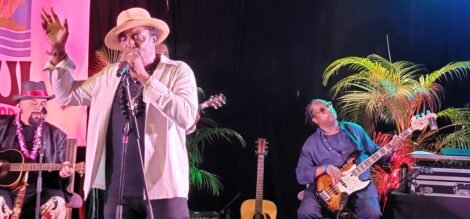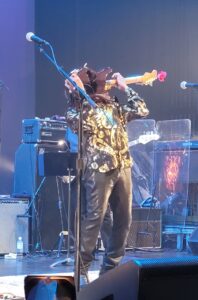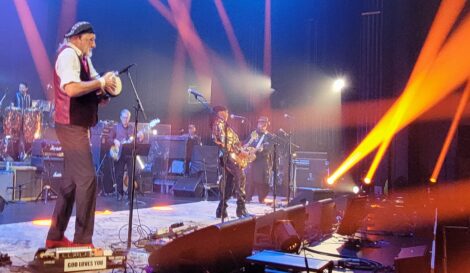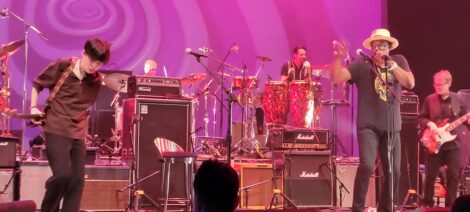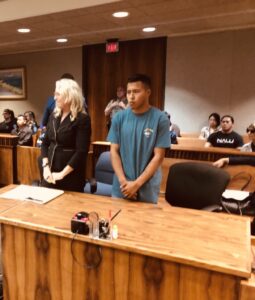Maui resident Fred Spanjaard remembers Live Aid on 40th anniversary
- Bernard Fowler (center) Nicholas Tremulis (left) and Rolling Stones’ bassist Daryl Jones (right) in Kapalua 2024. For the Maui News/Jon Woodhouse
- Ernie Isley of the Isley Brothers playing guitar with his teeth ala Jimi Hendrix at the MACC 2024. For The Maui News/Jon Woodhouse
- Ernie Isley (right) Mick Fleetwood (left) at the MACC 2024. For The Maui News/Jon Woodhouse
- Photo 4: Bernard Fowler (right) with Maui’s Kenny Blue at the MACC 2024. For The Maui News/Jon Woodhouse
Back in 1985 when Live Aid, the largest charity concert ever held, was presented simultaneously in London and Philadelphia, Maui resident Fred Spanjaard worked as a producer on the Philadelphia show, helping raise millions of dollars for Ethiopian hunger relief.
On the 40th anniversary of this epic event, the historic benefit is captured in a new four-part documentary, “Live Aid at 40: When Rock ‘n’ Roll Took on the World,” on CNN. The opening “A Band Aid” episode screened on Sunday, and subsequent episodes will screen on July 20 (“The Global Jukebox”), July 25 (“The Greatest Show on Earth”) and Aug. 3 (“Live 8 – 2005”).
“It was the first time the world had come together to watch a single event simultaneously,” Spanjaard explained. “It was very beautiful the way things came together. Everyone wanted to be a part of it. I was producing what was happening on what was called the second stage. There was a main stage where the musical acts were happening and another stage where we had celebrity actors like Jeff Bridges, Sally Field and Don Johnson. They went out there during the in-between performances and did little pieces about ending world hunger. The celebrities addressed how hunger could actually end and that it did not need to exist. This was radical at the time as no one thought hunger could actually end, just simply be alleviated by sending food. Those of us that had been working to end world hunger in the years prior, we were all about using Live Aid to educate, inspire and call people to action.”
In addition to extended highlights of the London and Philadelphia concerts, the series features backstage footage and interviews with the concerts’ mastermind Bob Geldof, U2’s Bono, Sting, The Who’s Pete Townshend, Queen’s Brian May and Roger Taylor, Phil Collins, and Lionel Richie, along with former President George W. Bush and Condoleezza Rice.
Live Aid was one of the biggest global television events of all time. An estimated 1.9 billion people across the world tuned in for the concert broadcast. The telecast reached more than 500 million of the world’s approximately 600 million TV sets, including in the Soviet Union and China.
“We utilized 16 satellites to make it happen,” Spanjaard recalled. “This was the first time the technology had been used to bridge the world simultaneously on one global event.”
Employing satellite technology, David Bowie and Mick Jagger had agreed to perform a transatlantic duet, with Bowie in London and Jagger in Philadelphia.
“But when they went to rehearse it, there was a split-second delay and they couldn’t pull it off,” he said. “So they spontaneously went into a studio and laid down a video of ‘Dancing in the Street.'”
ABC was contracted to broadcast the last two hours of Live Aid, with Dick Clark hosting the ABC prime time feed to the world.
“One o’clock in the morning and I got a call in my hotel room from Dick Clark’s producer,” Spanjaard recalled. “He said, ‘Can Dick and I come down to your room? We understand that you have a VCR in your room. We have this tape delivered to us from David Bowie and Mick Jagger and we have to view it before we run it. So can we come look at it?’ I am sitting on my bed at the Four Seasons in Philadelphia with Dick Clark watching this video.”
Among the day’s highlights, he recalled that “Led Zeppelin coming on was really exciting. Teddy Pendergrass was quite an emotional moment. He was wheeled out and that was his first performance after his accident.” Maui’s Shep Gordon was his manager.
And the day after, “one of the memories I had was of Joan Baez. All of a sudden in the production office, the door opens up and it’s Joan Baez. She pops in and she says, ‘I just wanted to say what a great job you did and is there anything I can do to help you?’ I’ll never forget that.” Baez had opened the Philadelphia show announcing, “Good morning children of the 80s. This is your Woodstock, and it’s long overdue.”
Before working on Live Aid, Spanjaard had been involved in hunger projects in Los Angeles, including the “End Hunger” telethon in 1983.
“That day I was a producer,” he said. “I walked down the hall of NBC studios in Burbank, speaking personally one-on-one with Jack Lemmon, Gregory Peck, Burt Lancaster, Richard Pryor and an array of amazing movie icons.”
He was subsequently hired to work on the Philadelphia concert. “This was five weeks before Live Aid. I was tasked with setting up the production operation and liaising with the hotels and the city permits and the stadium and the media.”
The concerts in London and Philadelphia eventually raised over $125 million for famine relief. Unfortunately, it was later revealed the Ethiopian government had used some of the money to buy weapons to crush the opposition.
In the closing episode of “Live Aid at 40: When Rock ‘n’ Roll Took on the World,” Bono convinces the US government to pledge $15 billion to help those impacted by AIDS in Africa. In a new interview about this massive aid effort, President Bush pointedly emphasized, “A great nation should be a compassionate nation, and there’s nothing more compassionate than helping people who are condemned to death, live.”

